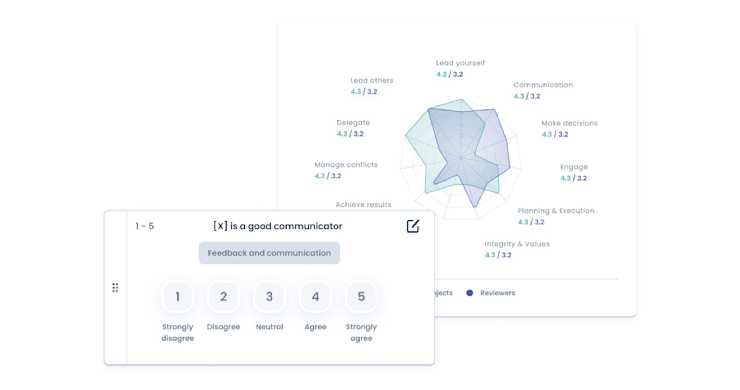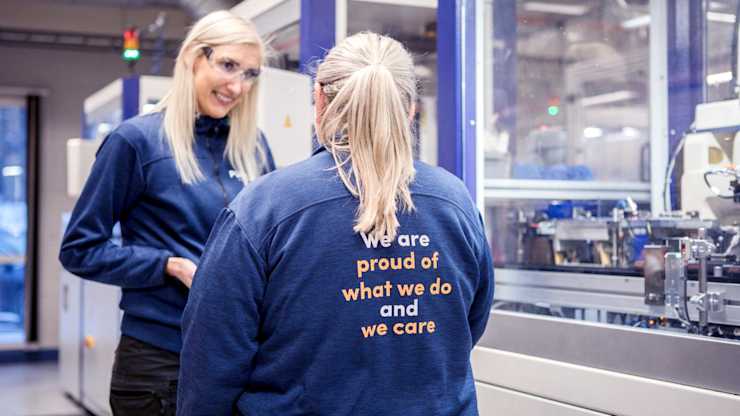The first step to building a better workplace is gathering employee feedback. Let's have a look at the different employee feedback tools and strategies that you can use.
Let's face it - getting honest, useful feedback from your team isn't always straightforward.
According to WorkHuman it’s a real challenge for 47% of HR leaders, so you’re definitely not alone.
This post aims to guide you through this sometimes murky territory with practical strategies and tools; from real-time pulse surveys to anonymous chats and customised employee surveys.
We'll delve into various ways you can get valuable insights directly from those who matter most: your employees.
What is employee feedback?
Employee feedback is the process where employees share their views, experiences, and suggestions about their job or workplace.
It's a vital part of communication in any organisation since roughly 41% of employees have quit their jobs because they didn't feel heard.
Employee feedback can be both formal and informal. It could take place during annual performance reviews, team meetings, or one-on-one discussions with managers.
But it doesn't stop there.
An effective feedback system goes beyond traditional methods by embracing modern tools like pulse surveys, anonymous chats, and open-ended questions that let your workforce speak openly.
The two-way street of feedback
In essence, think of employee feedback as a two-way street: you give to get.
By encouraging staff to express themselves freely without fear of reprisal, they're more likely to feel valued because their opinions matter.
This mutual dialogue fosters an environment conducive to growth - improving not just individual performance but also overall organisational effectiveness.
Why is employee feedback important?
The power of employee feedback can't be underestimated. It's the fuel that drives company growth, shapes culture, and helps retain top talent.
Gallup reports that a significant 79% of employees who resign attribute their departure to a 'lack of appreciation.' With this prevalent reason, organisations must attentively address the needs of their staff.
But there's more. Approximately 72% of corporate executives acknowledge that enhanced communication has led to increased productivity within their teams according to Grammarly’s 2023 state of Business Communication report.
So getting regular input from your team not only boosts morale but also results in better outcomes.
If you want a thriving business with engaged employees who feel valued, gathering regular feedback should be at the top of your priority list.
7 ways to get employee feedback from employees

1. How to get quick feedback from employees: conduct pulse surveys
Pulse surveys are a brilliant way to gather rapid employee feedback. They're short, snappy and simple - ideal for keeping your finger on the company's pulse.
Eletive's real-time pulse survey feature takes this idea further. It lets you catch early signs of burnout or dissatisfaction before they become major issues.
Besides being practical, these bite-sized check-ins can also be fun. Employees often enjoy sharing their views in an easy and low-pressure manner. This approach encourages honesty, making sure you receive genuine insights into how your team is feeling.
But gathering data is only half the story; what matters more is using it effectively.
Once collected, review the responses as a team or with individual staff members where appropriate. You might discover trends that warrant changes in policy or pinpoint specific areas needing attention.
To action these findings successfully requires understanding them fully first - so don't rush this stage.

2. How to get feedback from team members: Implement 360-degree feedback
One viewpoint gives limited information, but when you bring together different perspectives, you get a better understanding of individual success and teamwork.
It's like putting together a puzzle – each piece adds more detail to the whole picture.
360 degree feedback allows this to happen naturally.
Because by its very nature we’re collecting perspectives from team members across the entire organisation; from middle managers, to stockroom workers, to the CEO.
Everyone’s opinion gets taken into account.
Our platform collects the survey information, crunches the numbers and then helps you move forward with action plans.
Action plans address areas that need to be improved head-on—think less guesswork and more informed strategy-making.
Related feature: 360-degree feedback ultimate guide | benefits, tips & questions | Eletive
3. How to get honest feedback from employees: anonymous chat
Honesty is crucial when it comes to employee feedback. However, it can be difficult for some to share their true opinions without fear of repercussions. That's where Eletive's Anonymous Chat feature shines.
Our tool allows your team members to voice their thoughts and ideas without fear of judgement or backlash. Think of it as a digital suggestion box, but with instant delivery and zero chance for coffee stains.
Anonymity promotes open communication by taking the pressure off. Employees can express themselves freely, fostering an environment rich in honesty and transparency.
In essence, anonymous chats give your employees a safe space for discussion—like that comforting confessional booth on reality TV shows—but less dramatic.
Eletive champions this approach because we understand its power in encouraging frank dialogue within teams. We're all about breaking down barriers here.
4. How to get useful feedback from employees: Use open-ended questions
Gathering qualitative insights from your team can be a game-changer. But, how do you achieve that? The answer lies in open-ended questions.
Unlike their closed counterparts, open-ended questions give your staff the freedom to express their thoughts without constraints. They don't have to pick an option; they write what's on their mind. This allows for rich, nuanced feedback - the kind that could lead you straight into uncovering hidden gems of insight about your workplace culture and performance.
Making practical use of qualitative employee feedback
You’ve got this wealth of qualitative data now – but how do we use it practically?
Detecting issues: Reading between lines often reveals subtle yet significant issues not apparent otherwise.
Innovate: New ideas or suggestions coming directly from those who know best are invaluable.
Create dialogues: Responding to such comments creates more engaging discussions than standard yes/no conversations ever could.
5. Customise employee surveys
Tailoring surveys to your company's unique needs is a crucial step in collecting meaningful feedback.
With Eletive, you can create custom surveys that resonate with your specific goals and workplace challenges.
A generic strategy may not be suitable when it comes to obtaining valuable opinions from personnel. This could be compared to buying an outfit without trying it on first - there’s no guarantee of a good fit.
Eletive gives you the power to customise every aspect of your survey, allowing for more targeted data collection. From adjusting question types, setting up scales or even designing engaging layouts – flexibility is key.
Fine-tune questions to suit your needs
With Eletive's platform, fine-tuning questions based on organisational objectives becomes effortless.
It allows you not only to ask what matters but also encourages genuine engagement from employees by making them feel their voices matter.
Address specific workplace challenges
Sometimes businesses face unique issues that generic surveys fail to capture. Customising lets you dive deep into these specific areas and gain insights straight from those who experience them daily - the employees themselves.
The power of relevant feedback
A well-crafted customised survey often results in higher response rates because people are more likely to respond when they believe their feedback will have a direct impact. This means better data for decision-making processes at all levels within the organisation.

6. Conduct regular one-on-one meetings
To gain meaningful insight from your staff, make it a habit to have regular individual meetings. These catch-ups give employees the chance to voice their thoughts and concerns directly with managers.
One-to-ones can feel like navigating through uncharted waters if there's no structure. But don't fret. A simple approach is setting an agenda beforehand. It allows both parties to prepare, ensuring more productive conversations.
Eletive offers support for creating organisational templates for these vital check-ins. By using Eletive’s template for one-on-ones, you make sure all essential topics are covered while giving room for personal adjustments based on individual needs.
All this information isn’t meant just to sit idle in some forgotten folder though. Feedback collected during these meetings should be used actively as a resource when planning actions aimed at increasing engagement and performance within your teams.
How to get feedback from employees examples
To see real-world applications of gathering employee feedback, we can look at a couple of companies that have excelled in this area using Eletive's platform.

Mekonomen
Mekonomen, an automotive spare-parts chain, made use of pulse surveys and open-ended questions.
They were able to identify key areas for improvement by actively listening to their team’s responses.
These insights allowed Mekonomen not only to fix problems but also to create a more engaging workplace culture.
As a result, they saw significant growth in their overall engagement score over time - proving the value of seeking regular input from staff.

Purmo group
By automating HR processes, Purmo Group has saved valuable time and increased efficiency.
Our platform's flexibility in survey scheduling allows for a gradual increase in survey frequency, aligning with the organisation's evolving approach to employee feedback.
Empowering managers with administrative tasks has fostered a higher level of engagement and accountability within teams, moving away from surveys being solely an HR matter.
Particularly noteworthy is the use of Eletive's KIOSK feature and QR codes to engage blue-collar workers, providing a user-friendly method for them to participate in surveys.
Overall, this collaboration has not only streamlined workplace dynamics but also propelled Purmo Group closer to its vision of creating a thriving work environment for all employees.
Conclusion
Getting feedback from employees is no longer a mystery. It's all about utilising the correct resources and enquiring the appropriate queries.
Pulse surveys, for example, are your go-to for quick insights. They're fun, engaging and they spot burnout early.
The 360-degree tool? That gives you comprehensive feedback from different perspectives - something invaluable in any workplace!
An anonymous chat feature lets your team speak their mind without fear. Honesty is key to useful feedback after all.
And let’s not forget open-ended questions or customised employee surveys – both powerful ways to dive deep into what makes your team tick.
To round it off: one-on-one meetings provide that personal touch we sometimes need when trying to understand our people better.
All these strategies will help you figure out how to get feedback from employees effectively with Eletive's features aiding every step of the way. Talk to our sales team to discover whether Eletive could be a fit for your organisation today!
FAQ
How do you get employees to provide feedback?
To get employee feedback, make it simple and safe for them. Use tools like Eletive's pulse surveys or anonymous chat features to encourage honest responses. Make sure to take action on the results, to keep people motivated to participate.
How do you ask for feedback on employee performance?
A well-structured approach is key when asking for performance-related input. Employ 360-degree reviews and regular one-on-one meetings that focus on goals, progress, and areas of improvement.
How do I get feedback from my coworker?
If you need input from a colleague, just ask directly but politely. Also, you can propose an anonymous method like a 360° survey, if your organisation supports it.

























